Regeneration guidelines for faba bean
|
View regeneration guidelines in full (in PDF)
Also available in the following languages: |
The information on this page was extracted from:
Street K., Ismail A. and Rukhkyan N. 2008. Regeneration guidelines: faba bean. In: Dulloo M.E., Thormann I., Jorge M.A. and Hanson J., editors. Crop specific regeneration guidelines [CD-ROM]. CGIAR System-wide Genetic Resource Programme, Rome, Italy. 9 pp.
Before reading the regeneration details for this crop, read the general introduction that gives general guidelines to follow by clicking here.
Introduction
Faba bean (Vicia faba L.) belongs to the Fabaceae family and has many common names. It is native to northern Africa and south-west Asia, where it is extensively cultivated. The species spread from the Mediterranean region to Europe and then through Eurasia and to parts of the New World. Extensive cultivation occurs in all these regions, particularly in China. Although classified in the same genus as the vetches (Vicia), some botanists argue that the species should be treated as a separate monotypic genus; Faba sativa Moench or Faba bona Medik. No wild progenitor of faba bean has been identified and the species does not produce fertile hybrids with any other Vicia species.
Faba bean is a diploid species, 2n=12 (six homologous pairs) and partly out-crossing; cross-pollination is reported to range from 8% to 84%, with an average of 35% (Bond and Poulsen 1983). The plant is rigid and erect, growing to 0.5 to 1.7 m tall. The leaves are 10–25 cm long, pinnate with two to seven leaflets and have a distinct grey-green colour. Faba bean differs from most other vetches in that the leaves do not have tendrils for climbing. The pods are green, broad and leathery. When mature they are blackish-brown with a dense, downy surface. Three distinct types, based on seed size, are commonly recognized: the large-seeded variety major; the intermediate variety equina and the small-seeded variety minor.
Given the high degree of allogamy (cross-fertilization) within Vicia faba germplasm, it is important to optimize the regeneration procedure. Freshly harvested seed must be processed rapidly and efficiently to maintain seed quality so that the periods between regeneration are as long as possible. This guideline applies to genebank accessions of faba bean, including commercial varieties, breeding material, pure lines and landrace populations.
 A faba bean plant. (photo: ICARDA) |
Choice of environment and planting season
Planting season
- Plant during the rainy season in Mediterranean-type environments (winter planting). Sow after the first substantial rainfall event of the season and when there is a high likelihood of subsequent rainfall.
- Sow in spring in northern Europe and America, simultaneously with spring cereals, i.e. the end of April to the beginning of May.
- Where the rainy season coincides with warm, humid weather, plant during the post-rainy season as temperatures and humidity decline. In India, this is during October. This wil reduce pressure from diseases and pests. The short days of the post-rainy season also induce flowering in photosensitive germplasm, thus enabling seed production.
Preparation for regeneration
Use screenhouses to prevent insect-facilitated cross-pollination
- To maintain the genetic integrity of accessions, take special care to prevent out-crossing between accessions but facilitate crossing between individuals within accessions to avoid inbreeding depression.
- Ideally, plant the accessions in isolation fields outdoors and separate them from each other by at least 500 m; this allows natural pollinators to pollinate within accessions but not between them.
-
Alternatively, use isolation cages or screenhouses to limit the movement of pollinators between accessions (see photo). Ideally, screenhouse structures should be collapsible so they can be moved from one part of the field to another from season to season. They should be tall enough to allow for easy plot maintenance and large enough to allow multiple plots to be planted. The screen should be made of a robust, UV-resistant material with a mesh size small enough to prevent bees and other insects access to the plants whilst also letting in adequate light. The screen should also be porous enough to allow wind to pass through the structure, as the movement of plants in the wind leads to more self-pollination. The screenhouses used at ICARDA are 32 m long, 32 m wide and 2.5 m high.
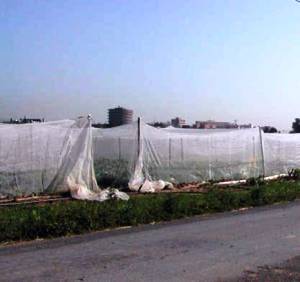
Isolation cages without pollinators at IFAPA (Instituto Andaluz de Investigación y Formación Agraria, Pesquera, Alimentaria y de la Producción Ecológica), Centro Alameda del Obispo, Córdoba, Spain. (photo: Salvador Nadal)
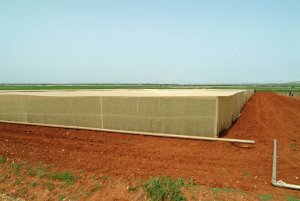
Isolation cages of Faba bean. (photo: ICARDA)
- Erect screenhouses over plots after planting but before the onset of flowering. Inspect the mesh for damage and repair holes immediately.
- Pile soil onto the mesh screening where it meets the ground to ensure there are no gaps at the base of the structure.
- To avoid inbreeding depression and subsequent genetic erosion, cross-pollinate between individuals within accessions artificially using standard hand cross-pollination techniques regularly used by breeders. If you are not familiar with these techniques, seek a demonstration by a trained technician or breeder.
- Alternatively, instead of using one large exclusion cage, erect separate mini-exclusion cages over each accession and introduce pollinators into each cage.
- There are pros and cons associated with each method so you will need to consider what is practical to do with the resources at hand.
When to regenerate
- For genetically diverse populations, when seed stocks in the active collection fall below 400 seeds.
- For genetically fixed material, such as breeding lines, regenerate when stocks fall below 250 seeds.
- When germination of seeds in either the active or long-term collections drops below 75%. ICARDA observes a standard of 90%.
Preparing seed for planting
- Treat seeds with appropriate fungicide and insecticide.
- Label seed packets with the accession identity number and intended plot number.
Field selection and soil preparation
- Fusarium wilt and chocolate spot are the major limitations to crop growth during regeneration of faba bean. They can be controlled through solarization of soil and field rotation, e.g. cereals–legumes–fallow.
- Sow into well-drained, weed-free soil to ensure a good reserve of soil moisture.
- Faba bean grows best on alkaline soil.
- Deep plough to invert the soil, followed by two or three harrowings to create a fine tilth and level planting bed.
- Make ridges spaced 45 cm apart and plant seeds into the furrow created between the ridges.
Method of regeneration
Planting layout, density and distance
- For accessions of landraces and variable populations, plant at least 150 seeds in six rows (25 seeds per row). Use rows of 3 m long to maintain the diversity in the accession.
- For pure-line material that is genetically fixed (genetically uniform), 20–30 plants should yield adequate amounts of seed to top up seed stocks.
- Separate plots from each other by at least 90 cm.
Sowing method
- Sowing is best done by hand. Dibble one seed every 12 cm into a 5-cm-deep furrow created between the ridges, which are 45 cm apart. This allows adequate space for mechanical cultivation to control weeds when the plants are small and also allows for flood irrigation later in the season when the cages are constructed over the plots.
- Close the furrow when the seeds are placed.
Plot labelling
- Label each plot with the plot number and the accession’s unique identifying number (for example the IG number is used at ICARDA) written onto a plastic tag fastened to a stake about knee high. Use plastic labels and markers that can withstand weathering. Use labels with duplicate information that is harvested with the plants/seed and stays with the sample at all times, to reduce the risk of misidentification.
Crop management
Weed management
- Immediately after planting apply a pre-emergence herbicide mixture that targets both cereal and broadleaf weeds. For example, a mixture of propyzamide and terbutryn is used at ICARDA.
- Cultivate between rows twice during early stages of plant growth using a mechanical cultivator.
- Weed by hand at later stages if required.
- Eliminate off-types and plants growing outside the row by hand.
Fertilization
- Apply a basal dose of diammonium phosphate at 100 kg/ha.
Irrigation
- Irrigate the field immediately after sowing. Apply supplementary irrigation when necessary to ensure adequate seed yield. Plants should not become so water-stressed that flower or pod abortion occurs or pod-filling is impeded.
Common pests and diseases
Contact plant health experts to identify the symptoms of the likely pests and diseases and the appropriate control measures. Common pests and diseases include:
Pests
- Field pests: aphids, leafminer, Sitona weevil, Spodoptera spp., stem borers, thrips.
- Store pests: Bruchus spp., Callosobruchus spp.
Diseases
- Ascochyta blight (Ascochyta fabae)
- Root rot/wilt (Fusarium spp., Rhizoctonia spp., Scelerotinia spp., Helminthosporium spp.,etc.)
- Rust (Uromyces fabae)
- Powdery mildew (Erysiphe polygoni, Leveilulla taurica)
- Downy mildew (Peronospora sp.)
- Chocolate spot (Botrytis fabae, B. cinerea)
- Leaf spot (Alternaria spp., Cercospora spp.)
- Bean leaf roll virus (BLRV) and similar luteoviruses
- Bean yellow mosaic virus (BYMV)
- Broad bean stain virus (BBSV)
- Broad bean witch’s broom virus (BBWBV)
Nematodes
- Stem nematode
- Root lesion nematodes
Parasites
- Orobanche spp.
- Cuscuta spp.
Pest and disease control
- Coordinate periodic field inspections with pathologists and virologists during the growing season.
- Spray with appropriate chemicals when necessary.
Pollination and pollinator behaviour
- Adequate pollinators are solitary bees, honey bees, Sylocopa.
- Coordinate periodic field inspections with an entomologist during the growing season to identify pollinators and evaluate the accessions for phenological and floral morphological traits.
- Identify the most efficient pollinators.
- Determine relationship of the pollinator with flower morphology (see photos below).
 |
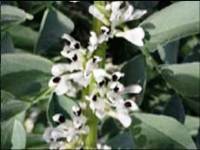 |
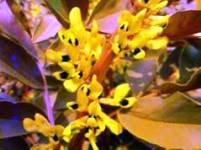 |
|
Examples of different flower morphologies of faba bean. (photos: J.L.Ubera) |
||
Harvesting
Harvest when pods become dark and dry. Dryness can be judged by the rattling sound pods make when shaken. Harvest by hand.
1. Hold the stem at the base and pul the plant from the soil.
2. Tie the uprooted plants from a row into small bundles and label them with accession number and field plot number.
3. Thresh the pods from individual plants on a tarpaulin by gently beating with sticks and collect the seeds into paper packets.
4. Take care to avoid spill over and seed mixing during threshing.
Desiccation of the plants can improve harvestability. A desiccant can be applied some days before and up to harvest.
Post-harvest management
1. Manually clean large-seeded accessions of any contaminating debris in a way that causes least damage to the sample.
2. For small-seeded accessions whose seeds wil pass through the sieves of a seed-cleaning machine, clean mechanical y, fol owed by a second hand cleaning to eliminate any further debris that passed through the mechanical process.
3. If using a machine, clean it meticulously after each accession.
4. If signs of insect attack are detected, it may be wise to fumigate the harvested seeds with an appropriate insecticide. However, this is not generally recommended, especially for long-term storage.
5. Determine total weight of cleaned seeds.
6. Determine 100-seed weight.
7. Dry accessions by placing seed in a low humidity, standard room temperature environment that is kept constant for up to 3 weeks. If using a control ed seed drying room, drying at 15°C and 15–20% RH is recommended. If a drying room is not available, dry seeds to a moisture content of less than 3–7% with silica gel or other appropriate desiccant.
8. Determine moisture content—it should be 3–7% for storage.
9. Send a subsample of each accession for viability testing.
10. Process the material for storage.
Monitoring accession identity
Maintaining the correct identity of accessions
When processing seed for planting, during planting, in the field, during harvest and post-
harvest, make sure that the seeds of a given accession remain with the correct identity
number. Always label packets of seeds, plots and harvested material with the appropriate
ID number in such a way that there is no chance of mixing up or losing the identity of the
accession.
Maintaining population integrity
When conserving accessions of genetically diverse populations, it is important to maintain
adequate seed numbers to maximize the diversity of the sample, i.e. a minimum of 4000
seeds. When regenerating such accessions, it is equally important to plant an adequate
number of seeds to capture the original variation in the population and ensure that genetic
drift does not occur within the population (see introductory chapter).
For active collections where seed reserves could be run down rapidly due to requests it is
advisable to plant enough seed to produce a large amount of seed (1–2 kg) to minimize the
number of regeneration events and hence to avoid genetic drift.
Comparisons with previous passport or morphological data
Compare each accession with the following characterization data previously recorded for
the accession:
- Growth habit
- Flower colour
- Seed colour
- Seed shape
If the identity of the accession is in doubt, check it against its herbarium voucher specimen.
Discard the accession if its identity is not the same as the original accession.
Documentation during regeneration
Collect the following information during regeneration and record it in the genebank
information system:
- Regeneration site name and map/GPS reference
- Name of scientist involved in regeneration
- Field/plot/nursery/greenhouse reference
- Accession number; population identification
- Source of seed
- Previous multiplication or regeneration references
- Preparation of planting materials (pre-treatments)
- Sowing date and density
- Field layout used
- Field management details (watering, fertilizer, weeding, pest and disease control, stresses recorded, others)
- Environmental conditions (altitude, precipitation, soil type, others)
- Emergence in the field or greenhouse (number of plants germinated)
- Number of plants established
- Days from sowing to flowering
- Harvest date and method
- Number of plants harvested
- Quantity of seeds (approximate weight)
- Agronomic evaluation; agro-morphological traits recorded
- Taxonomic identification
- Post-harvest (uniformity of maturity, lodging susceptibility)
References and further reading
Bioversity International, ICARDA. 2009. Key access and utilization descriptors for faba bean genetic resources. Bioversity International, Rome, Italy; International Center for Agricultural Research in the Dry Areas, Syria. Available here.
Bond DA, Poulsen MH. 1983. Pollination. In: Hebblethwaite PD, editor. The Faba Bean (Vicia faba L.). Butterworth, London, UK. pp. 157–179.
Muratova VS. 1931. Common beans (Vicia faba L.). Bulletin of Applied Botany of Genetics and Plant Breeding. 50th supplement. pp. 248–285.
Acknowledgements
These guidelines have been peer reviewed by María José Suso, Instituto de Agricultura Sostenible (CSIC), Spain, Margarita Vishnyakova, N.I. Vavilov Research Institute of Plant Industry (VIR), Russia, and Mike Ambrose, John Innes Centre (JIC), UK.
Comments
- No comments found



 Faba bean
Faba bean
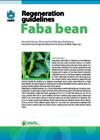
Leave your comments
Post comment as a guest